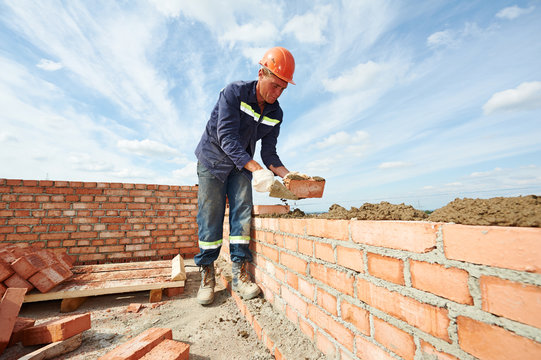Some Known Details About Bricklayer Auckland
More About Bricklayer Auckland
Table of ContentsThings about Bricklayer AucklandAn Unbiased View of Bricklayer AucklandThe Facts About Bricklayer Auckland UncoveredBricklayer Auckland Can Be Fun For AnyoneThe Basic Principles Of Bricklayer Auckland Not known Facts About Bricklayer Auckland
Bricks need to constantly be piled on slabs; never pile them straight on uneven or soft ground. Do not save bricks on scaffolds or paths.Except where piled in sheds, block piles should never be even more than 7 feet high. When a stack of brick gets to an elevation of 4 feet, it should be tapered back 1 inch in every foot of height above the 4-foot degree. The tops of block heaps need to be kept degree, as well as the taper must be preserved during unpiling operations.
Architectural bond refers to how the individual masonry devices interlock or link with each other right into a solitary structural system. Using cement to stick nearby wythes of masonry.
Little Known Facts About Bricklayer Auckland.
Pattern bond describes the pattern created by the masonry systems and mortar joints on the face of a wall (Bricklayer Auckland). The pattern might arise from the structural bond, or it may be purely attractive as well as unassociated to the structural bond. Number 4-4 reveals the six fundamental pattern bonds alike usage today.
The running bond is the simplest of the six patterns, containing all stretchers. Because the bond has no headers, metal ties usually develop the structural bond. The running bond is utilized mainly in dental caries wall surface building and construction, brick veneer walls, as well as encountering tile walls made with extra large stretcher tile.
Examinations to locate the high quality of blocks have been studied in the previous post. Excellent blocks ought to not degenerate when put in water. This is really crucial as when these blocks are used with cement mortar, we ought to extensively saturate them before laying. Just when fat lime or clay mortar is made use of or when one is required to utilize blocks that are not well burned, this soaking regulation needs to be kicked back.
The Greatest Guide To Bricklayer Auckland
In all cases, blocks should not be taken care of in baskets or in any type of other mode which will certainly ruin the intensity of their sides. A layer of mortar is spread out to cover the complete size of the wall surface for an appropriate size of the lower course.
Finally, we push the side bulging mortar in firmly to be level with the face of the wall if it is to be left unplastered. In the typical technique embraced by many masons, a row of blocks is very first positioned on a slim layer of bed mortar leaving the cross joints vacant.


Strictly this is not a good technique. (However, when utilizing cement mortar of high toughness, the loss of stamina as a result of offense of these guidelines may be only limited.)The walls are increased genuinely plumb. All training courses are laid truly straight and also all upright joints absolutely upright. Upright joints in alternate courses should come straight, one over the various other.
Our Bricklayer Auckland Diaries
For this function, a wood straight edge with graduation giving a thickness of each brick training course including joint can be made use of for assistance. For a thick wall surface, the above operation is repeated together with both faces of the wall as well as the interior filling up blocks for the thick wall surface are laid in a comparable way.
This procedure of filling up open joints is called flushing-up. It is incorrectly left out for a number of training courses on some badly-executed work and also only done later on (not after every useful content training course) in an inefficient manner. It is not a great technique and ought to be stayed clear of as it is crucial that every program must be purged approximately the degree if good work is called for.

3 Simple Techniques For Bricklayer Auckland
The mortar rising and loading the upright joints totally as well as develops an exceedingly strong as well as solid wall. This is called larrying. For a rat trap bond work (as in the building of tooth cavity wall surfaces), if the mortar is positioned carelessly on the block, some of it will certainly come under the cavities and will be wasted.
The face of the brickwork shall additionally be cleansed of all mortar droppings, etc(ii) When conditions make it essential to continue a part of a structure in irregular programs, the job will be constructed back (according to the bond utilized on the work) at an angle not steeper than 45 levels so regarding make sure an attire and also efficient bonding.
Or else, for faces to be glued, completing of the face joints ought to be lugged out check my blog as gone over in listed below (This is extremely important.)(iv) The walls need to be consistently elevated throughout not leaving any component one metre (three feet) reduced than the other - Bricklayer Auckland. A day's job must not be even more than 1.
Examine This Report about Bricklayer Auckland
When the facework is to be later special info plastered or the joints alone are to be sharp, the joints have to be raked while the wall is being developed. Bricklayer Auckland. It needs to be raked to a minimum depth of 12 mm by a raking tool throughout the development of the job itself, when the mortar is still eco-friendly.
If gluing or aiming is not imagined, the joints should be struck flush as well as finished at the time of laying itself, as already stated. Half-brick walls have a tendency to fracture unless care is taken in its building. Brickwork in half-brick stonework is to be lugged out with cots in 1: 5 mortar.